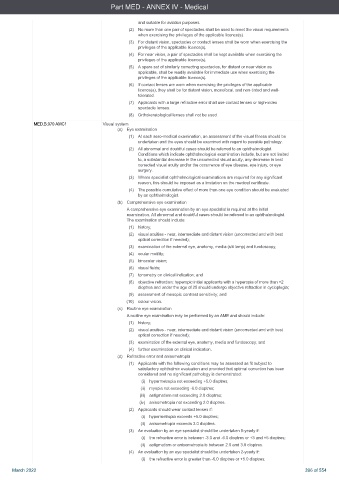Page 396 - UK AirCrew Regulations (Consolidated) March 2022
P. 396
Part MED - ANNEX IV - Medical
and suitable for aviation purposes.
(2) No more than one pair of spectacles shall be used to meet the visual requirements
when exercising the privileges of the applicable licence(s).
(3) For distant vision, spectacles or contact lenses shall be worn when exercising the
privileges of the applicable licence(s).
(4) For near vision, a pair of spectacles shall be kept available when exercising the
privileges of the applicable licence(s).
(5) A spare set of similarly correcting spectacles, for distant or near vision as
applicable, shall be readily available for immediate use when exercising the
privileges of the applicable licence(s).
(6) If contact lenses are worn when exercising the privileges of the applicable
licence(s), they shall be for distant vision, monofocal, and non-tinted and well-
tolerated.
(7) Applicants with a large refractive error shall use contact lenses or high-index
spectacle lenses.
(8) Orthokeratological lenses shall not be used.
MED.B.070 AMC1 Visual system
(a) Eye examination
(1) At each aero-medical examination, an assessment of the visual fitness should be
undertaken and the eyes should be examined with regard to possible pathology.
(2) All abnormal and doubtful cases should be referred to an ophthalmologist.
Conditions which indicate ophthalmological examination include, but are not limited
to, a substantial decrease in the uncorrected visual acuity, any decrease in best
corrected visual acuity and/or the occurrence of eye disease, eye injury, or eye
surgery.
(3) Where specialist ophthalmological examinations are required for any significant
reason, this should be imposed as a limitation on the medical certificate.
(4) The possible cumulative effect of more than one eye condition should be evaluated
by an ophthalmologist.
(b) Comprehensive eye examination
A comprehensive eye examination by an eye specialist is required at the initial
examination. All abnormal and doubtful cases should be referred to an ophthalmologist.
The examination should include:
(1) history;
(2) visual acuities - near, intermediate and distant vision (uncorrected and with best
optical correction if needed);
(3) examination of the external eye, anatomy, media (slit lamp) and fundoscopy;
(4) ocular motility;
(5) binocular vision;
(6) visual fields;
(7) tonometry on clinical indication; and
(8) objective refraction: hyperopic initial applicants with a hyperopia of more than +2
dioptres and under the age of 25 should undergo objective refraction in cycloplegia;
(9) assessment of mesopic contrast sensitivity; and
(10) colour vision.
(c) Routine eye examination
A routine eye examination may be performed by an AME and should include:
(1) history;
(2) visual acuities - near, intermediate and distant vision (uncorrected and with best
optical correction if needed);
(3) examination of the external eye, anatomy, media and fundoscopy; and
(4) further examination on clinical indication.
(d) Refractive error and anisometropia
(1) Applicants with the following conditions may be assessed as fit subject to
satisfactory ophthalmic evaluation and provided that optimal correction has been
considered and no significant pathology is demonstrated:
(i) hypermetropia not exceeding +5.0 dioptres;
(ii) myopia not exceeding -6.0 dioptres;
(iii) astigmatism not exceeding 2.0 dioptres;
(iv) anisometropia not exceeding 2.0 dioptres.
(2) Applicants should wear contact lenses if:
(i) hypermetropia exceeds +5.0 dioptres;
(ii) anisometropia exceeds 3.0 dioptres.
(3) An evaluation by an eye specialist should be undertaken 5-yearly if:
(i) the refractive error is between -3.0 and -6.0 dioptres or +3 and +5 dioptres;
(ii) astigmatism or anisometropia is between 2.0 and 3.0 dioptres.
(4) An evaluation by an eye specialist should be undertaken 2-yearly if:
(i) the refractive error is greater than -6.0 dioptres or +5.0 dioptres;
March 2022 396 of 554

